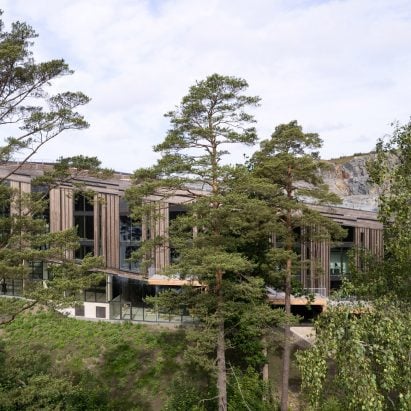Architecture studio Snøhetta has unveiled Lakehouse, a concrete-and-timber community centre in Mölnlycke, Sweden, with a walkable green roof designed to mimic treetops.
Located in a new residential area called Wendelstrand, the 6,264-square-metre community centre has a fitness centre and office spaces as well as restaurants.
It was created as a shared space for incoming residents of the area, which is close to the Swedish city of Gothenburg.
Lakehouse is located in a former quarry
The site is a former quarry, surrounded by forests, which Snøhetta has been part of transforming since 2017.
“The quarry hasn’t been filled in; the building is anchored directly into the rock,” Snøhetta project lead Anne Cecilie Haug told Dezeen.
“The challenge – and also the beauty – was the vast amount of gravel and exposed stone, combined with a lack of vegetation and water retention.”
The building rises from the ground and has a walkable roof
Designed to blend into the landscape, the Lakehouse building has a curved rectangular shape and rises like a pathway from the ground, allowing visitors and residents to walk the length of its roof.
“The elongated structure rises like a spine in the landscape, creating a seamless transition between the existing and the new, indoors and outdoors, and private and shared space,” Snøhetta said.
“The area’s past as a quarry and the natural terrain structures inspire both the form and materials.”
The timber building overlooks a lake and has outdoor landscaping
The studio designed the roof itself to “mimic treetops” with terraces, gardens and walkways.
It was covered with moss, heather, blueberries and other native plants to make it look like a forest floor, a design that Snøhetta says also helps slow water runoff and support biodiversity.
“The roof extends the building into the landscape,” Haug said. “It invites people up and over, from the old quarry basin to panoramic views of the surroundings.”
“Covered in gravel and forest floor, it creates the feeling of walking a natural trail,” she added. “This transforms a functional surface into a public experience – something to discover, use, and enjoy all year round.”
The windows are patterned to provide shade
Large glass panels clad the exterior of the building and have strategically placed patterns to minimise the need for sunshades.
These were designed to create a play of light similar to that of sunlight through treetops, in another nod to the surrounding forest.
The two lower floors of the building were made from concrete and stone and embedded in the bedrock of the quarry.
A central atrium with curved-timber ceiling details spans all the floors and will eventually host performances and concerts.
“The structure is made of GLT timber – robust, beautiful, and sustainable,” Haug said. “Only the parts that go into the ground are made of concrete.”
The atrium and amphitheatre space will be used for events
The ground floor also features amphitheatre seating that continues outside the building to create a viewpoint overlooking a nearby lake.
“The amphitheater is designed for events like concerts, educational programs, community gatherings, openings, and parties,” Haug said.
“When not in use for events, it becomes a space where people can sit and enjoy the openness, work, have a coffee, or read. Its key quality is flexibility – it’s a community space that can adapt to different uses over time.”
The top floors were made from glulam and laminated timber
The Lakehouse’s two top floors were made from glue laminated timber, with the material left visible on interior. A winding timber staircase connects the floors, contrasting against the lower-ground floor’s concrete walls.
In the office spaces and communal areas, natural-hued wood panelling clads the walls.
The timber structure is visible in the interior
The overall aim of the Lakehouse project was to “help nature reclaim the space” from the quarry, according to Snøhetta.
“The Lakehouse sits in a landscape shaped by a century of quarrying,” Haug said. “Our goal was to help nature reclaim the space – turning the grey into green.”
“Architecture and landscape work together here, from generous lake views to a stepped amphitheatre that invites planned and spontaneous gatherings,” she added.
“The building follows the terrain’s natural rise, acting as both a threshold to the new neighbourhood and a soft edge between untouched nature and future development.”
Other recent Snøhetta projects include the Museum of Sex in Miami and a cloud-like children’s museum in El Paso.
The photography is by Kalle Sanner.
Project credits:
Client: Next Step
Architecture, interior architecture, landscape architecture for roof terraces: Snøhetta
Entrepreneur: BRA Bygg
Landscape architect street level: White Arkitekter
Interior architecture, rental areas: Arkitektbyrån Design
The post Snøhetta designs community centre in former quarry to “rise like a spine in the landscape” appeared first on Dezeen.
